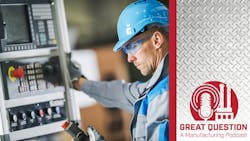Podcast: How AI and automation are revolutionizing computer-aided manufacturing
Olivier Thenoz is product manager for CAM at Hexagon Manufacturing Intelligence, which develops program technologies for design and engineering and for production of engineered parts. He has been in the industry for over 25 years with roles ranging from application engineer to research and development for CAM systems and product manager for production machining. Olivier recently spoke with Robert Brooks, editor in chief of American Machinist and Foundry Management & Technology, about how new technologies like artificial intelligence and digital twins are changing CAM systems.
Below is an excerpt from the podcast:
AM: What is the current state of CAM for programmers and operators of CNC machines?
OT: It's interesting to talk about how CAM evolved. Historically, CAM was really focused on a geometric approach to past generations, not considering machines too much. And as machines got more complex, the users were asking for better tools for verifying the tool paths before putting it on the machine, and so the CAM systems started integrating this machine consideration.
Today I will say we have two main approaches to traditional CAM systems. The first approach program is fairly agnostic to the machine, and towards the end of the programming when you want to simulate and you want to generate G-code, that's when the machine is taken into consideration. But that approach leads often to inefficiencies and errors being discovered too late, so a lot of back and forth. The second approach of traditional CAM systems is incorporating the machine specificities up front. So you're just selecting a machine, you’re programming a machine, you're programming your setup. But all the user's decisions will be ready tailored to this specific setup, but it will lack the flexibility when the production needs to change because the machine is not available anymore or the volume of production changes and you want to move the production to a different machine. It's very inflexible programming because all the decisions specific to the programming are on the users.
So, what we're seeing is a new generation of CAM systems powered by AI and digital twin technologies. The CAM system integrates implicit machine knowledge and offers adaptivity and machine-specific optimization without requiring all these user decisions. So basically the system knows about the machine. What are the capabilities of the machine? What is the performance of the machine? What are the user preferences? And the user will have a more agnostic approach to the programming, and the system will automatically adapt the process to make it work the most optimum way on the machine.
AM: What you are describing is an emerging state, not the current state, if I understand you correctly.
OT: That's correct. With this new generation of CAM systems, that's what we are starting to see.
AM: How is the absorption rate? Is the audience understanding what changes are being presented to them, or is it a little bit difficult for them to grasp the switch here?
OT: I think it's good to have this podcast to talk a bit more about this, because I think it's kind of new for users to understand the benefits of AI and how it can benefit CAM. We talked about the limitations of the traditional CAM system. I talked about flexibility, the struggle with flexibility, if setup changes or the machine changes, you need to reprogram a lot of things. Another limitation is it requires expertise on the machine from the user. So you get expertise bottleneck that occurs with only a few individuals in the shop being able to fully understand the intricacies of the machine to program the machine. The other problem with traditional CAM systems is that errors are often detected too late, leading to long prove out time, so more time to get into production.
AM: Is there a need to build up the cloud or the database of information to inform these shops, or is that integral with the new design of CAM?
OT: With the new CAM systems powered by AI, they can be used in different ways. So first AI can adapt the process to the machine using this implicit knowledge of the machine given by the digital twin. The other way AI improves and benefits CAM is with machine learning technology by learning the processes, improving the programming based on what the user did, and being able to predict future actions, reusing the best processes. And that's where the cloud comes into play. This type of machine learning, storing the data from multiple users, sharing best practices among users, that's where the cloud becomes very important in combination with AI and the digital twin.
About the Podcast
Great Question: A Manufacturing Podcast offers news and information for the people who make, store and move things and those who manage and maintain the facilities where that work gets done. Manufacturers from chemical producers to automakers to machine shops can listen for critical insights into the technologies, economic conditions and best practices that can influence how to best run facilities to reach operational excellence.
Listen to another episode and subscribe on your favorite podcast app
About the Author
Robert Brooks
Robert Brooks has been a business-to-business reporter, writer, editor, and columnist for more than 20 years, specializing in the primary metal and basic manufacturing industries. His work has covered a wide range of topics, including process technology, resource development, material selection, product design, workforce development, and industrial market strategies, among others. Currently, he specializes in subjects related to metal component and product design, development, and manufacturing — including castings, forgings, machined parts, and fabrications.
Brooks is a graduate of Kenyon College (B.A. English, Political Science) and Emory University (M.A. English.)
